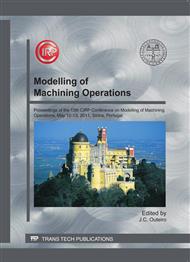[1]
Y. Ohbuchi and T. Obikawa: Adiabatic shear in chip formation with large negative rake angle, International Journal of Mechanical Sciences 47 (2005), pp.1377-1392
DOI: 10.1016/j.ijmecsci.2005.05.003
Google Scholar
[2]
Y. Ohbuchi and T. Obikawa: Surface Generation Model in Grinding with Effect of Grain Shape and Cutting Speed, JSME International Journal, Vol. 49, No.1 (2006), pp.114-120
DOI: 10.1299/jsmec.49.114
Google Scholar
[3]
F. Klocke: Modelling and simulation in grinding, 1st European Conference on Grinding, Aachen, Fortschritt-Berichte VDI Reihe 2 Fertigungstechnik (2003), p.8.1-8.27
Google Scholar
[4]
E. Brinksmeier, F. Klocke, A. Giwerzew and D. Vucetic: Spanbildungsmechanismen beim Schleifen mit niedrigen Schnittgeschwindigkeiten, Industrie Diamanten Rundschau, IDR 36, volume 4 (2002), pp.346-356
Google Scholar
[5]
A. Baus: Modellierung von Schleifprozessen – Eine komplexe Herausforderung, Laboratory for Machine Tools and Production Engineering, RWTH Aachen University (2002)
Google Scholar
[6]
H.-W. Hoffmeister and T. Weber: Simulation of Grinding by means of the Finite Element Analysis, 3rd International Machining & Grinding, Cincinnati, USA (1999)
Google Scholar
[7]
S. Okuyama, T. Nishihara, S. Kawamura and S. Hanasaki: Study on the Geometrical Accuracy in Surface Grinding – Thermal Deformation of Workpiece in Traverse Grinding, Int. J., Japan Soc. Prec. Eng., 28/4 (1994): pp.13-23
DOI: 10.1016/0141-6359(94)90270-4
Google Scholar
[8]
K. Weinert and M. Schulte: Profilschleifen hochharter Cr- und PM-Legierungen mit konventionellen Schleifmitteln, Annual "Grinding, Honing, Lapping and Polishing", 61st edition, Vulkan Verlag (2004), pp.128-136
Google Scholar
[9]
G. Warnecke and U. Zitt: Kinematic Simulation for Analyzing and Predicting High-Performance Grinding Processes, Annals of the CIRP 47/1 (1998), pp.265-270
DOI: 10.1016/s0007-8506(07)62831-5
Google Scholar
[10]
R. Rentsch and E. Brinksmeier: Tribology Aspects in state of the art MD cutting simulations, 8th CIRP Int. Workshop on Modeling of Machining Operations, Chemnitz, Germany (2005), pp.405-408
Google Scholar
[11]
C. Siemers, M. Bäker, D. Mukherij and J. Rösler: Microstructure Evolution in Shear bands during the Chip Formation of Ti6Al4V, Proceedings of Ti-2003 Wiley-VCH, Weinheim (2003), pp.839-846
Google Scholar
[12]
C. Siemers, Z. Badya, T. Leemet and J. Rösler: Development of Advanced beta-Titanium Alloys, Proceedings of the 8th AMMT'09 Conference, St. Petersburg, Russia (2009)
Google Scholar
[13]
J.T. Lin, D. Bhattacharyya and W. G. Ferguson: Chip Formation in the Machining of SiC-particle-Reinforced Aluminium-Matrix Composites, Composites Science and Technology 58 (1997), pp.285-291
DOI: 10.1016/s0266-3538(97)00126-7
Google Scholar
[14]
C.L. Wu, K.S. Wang and L.C. Tsai: A new electromagnetic quick stop device for metal cutting studies, Int. Journal of Advanced Manufacturing Technology (2006), pp.853-859
DOI: 10.1007/s00170-005-2608-y
Google Scholar
[15]
S.L. Soo, D.K. Aspinwall and R.C. Dewes: 3D FE modelling of the cutting of Inconel 718, Journal of Materials Processing Technology 150 (2004), pp.116-123
DOI: 10.1016/j.jmatprotec.2004.01.046
Google Scholar
[16]
A. Gente: Spanbildung von TiAl6V4 und Ck45N bei sehr hohen Schnittgeschwindigkeiten, Institute of Machine Tools and Production Technology, Technical University Braunschweig (2002), Vulkan Verlag
Google Scholar
[17]
G.R. Johnson and W.H. Cook: A constitutive model and data for metals subjected to large strains, high strain rates and high temperatures, 7th International Symposium on Ballistics (1983), pp.514-546
Google Scholar
[18]
T.Mabrouki and J.-F. Rigal: A contribution to a qualitative understanding of thermo- mechanical effects during chip formation in hard turning, Journal of Materials Processing Technology, Vol 176 (2006), pp.214-221
DOI: 10.1016/j.jmatprotec.2006.03.159
Google Scholar
[19]
A. Shrot and M. Bäker: Is it possible to identify Johnson-Cook law parameters from machining simulations, International Journal of Material Forming, Vol. 3 Suppl. 1 (2010), pp.443-446
DOI: 10.1007/s12289-010-0802-4
Google Scholar
[20]
Y.B. Guo, Q. Wen and K.A. Woodbury: Dynamic Material Behaviour Modeling Using Internal State Variable Plasticity and Its Application in Hard Machining Simulations, Journal of Manufacturing Science and Engineering, Vol. 128 (2006), pp.749-759
DOI: 10.1115/1.2193549
Google Scholar
[21]
H.-W. Hoffmeister and T. Wessels: Thermomechanische Wirkmechanismen bei der Hochgeschwindigkeitszerspanung von Titan- und Nickelbasislegierungen, edited by H.K. Tönshoff and F. Hollmann, High speed cutting of metal-based materials, Wiley-VCH, Weinheim (2005), pp.470-49
DOI: 10.1002/3527605142.ch21
Google Scholar


